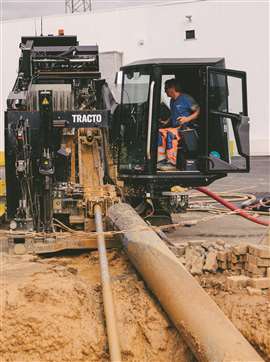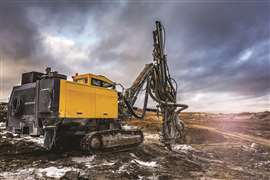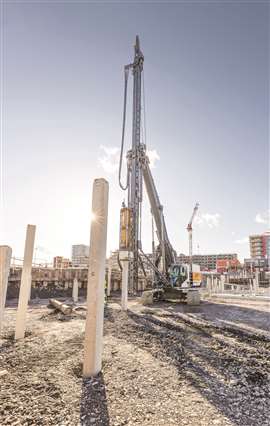Sustainable solutions: How can we reduce the impact of drilling on the environment?
16 February 2024
Drilling is a crucial component of construction, but its impact on the environment can be significant. Catrin Jones explores solutions.
Accurate drilling and foundations are essential components of every successful construction project. They form the foundation upon which structures stand, providing stability and durability in the face of varying environmental factors.
 Tracto’s GRUNDODRILL ACS3000 (Photo: Tracto)
Tracto’s GRUNDODRILL ACS3000 (Photo: Tracto)
Meinolf Rameil, chief technology officer and managing director at Tracto, says that the demand for trenchless technology is growing due to the increasing number of large infrastructure projects and the resulting need for gentle alternative methods.
Recently, Tracto developed the ORFEUS obstacle detection system for horizontal drilling applications. ORFEUS is a drill-head-based ground penetrating radar system that monitors the area around the drill head during the drilling process to prevent collisions and damage.
Rameil says the tool will “greatly increase the safety and efficiency of drilling operations and is expected to reduce third-party damage to underground utilities significantly.”
‘Unplugged’ potential
Liebherr is also developing tools to decrease the impact drilling has on the environment. The OEM’s LRH 100.1 unplugged machine was launched last year and is one of the world’s first battery-powered piling rigs. During operation, the deep foundation machine can be connected to a conventional electric supply or powered by a battery without a cable.
Liebherr says there are no restrictions on the performance and application of the machine when compared to the conventional version with a diesel engine.
Since their launch last year, Gregor Griesser, marketing manager at Liebherr, says there are already a couple of LRH unplugged units in operation, with a growing demand. “Currently,” he says, “We observe a very high demand in Scandinavia, North America, and Canada.”
Griesser also notes that it will take some time for the benefits to become widely recognised since they are among the first models in the market. He said, “The existing regulations in some countries and cities are a clear indication that the market must adapt, and zero-emission devices are becoming indispensable.”
Electric in action
Highlighting the practical benefits of electric drill rigs and the benefits they offer to both the project and the environment is Bauer. The Germany-based provider of services, equipment and products related to ground and groundwater used full e-power during a Dutch infrastructure project last year.
To manage the continually increasing traffic volume in the Dutch capital of Amsterdam, various infrastructure projects have been initiated by Rijkswaterstraat, the Dutch Ministry for Infrastructure and Waterways.
One of the most important of these projects is the large-scale Schiphol-Amsterdam-Almere Corridor road construction project. This includes expanding the A9 highway between Amsterdam Schiphol Airport, southern Amsterdam and the community of Almere to the east of the city.
Over a total of six construction phases, the existing three traffic lanes will be expanded to four in each direction. Furthermore, all connected structures have to be widened, and new interconnections with side roads have to be created, along with the construction of new bridges and tunnels.
 Liebherr LRH.100 unplugged (Photo: Liebherr)
Liebherr LRH.100 unplugged (Photo: Liebherr)
“One particular challenge is the limited workspace within the city and right next to the highway,” remarks Maarten Daalmeijer, project manager at Bauer Funderingstechniek.
For the first time, the newly developed electric KR 806-3E drilling rig from KLEMM Bohrtechnik GmbH is being used alongside a conventional drilling rig. The new development is equipped with a battery and a grid connection.
“We have already completed a full working cycle including drilling and expansion entirely using the battery’s energy reserves,” says Daalmeijer.
“Unloading, driving and transfer operations have also been carried out autonomously. Another crucial step has been taken in the area of electric drives for construction equipment.”
Drilling for HS2
Also joining Bauer Maschinen (BMA) is Cementation Skanska who in early 2023 joined the company to bring the world’s first plug-in, high-capacity drilling rig to work on the HS2 rail project in the UK.
The BMA eBG33 is said to replace the diesel engine drive with a powerful electric drive. By installing its own electric substation on the HS2 site, Cementation is reported to have been able to run the rig locally and emission-free. Those on the project said that using the grid connection removes any need to rely on a backup fuel powered generator.
Skanska reported that the eBG33 in London clocked around 360 hours working on site which equates to a saving of 116 tonnes of CO2 in local emissions while cutting noise emissions by 50% in rig idling and tracking mode.
Cementation Skanska operations director Andrew Entwistle, said, “The emission-free capability of this rig is an exciting step forward in our net zero ambitions.
 The industry is pushing towards sustainable solutions (Photo: Adobe Stock)
The industry is pushing towards sustainable solutions (Photo: Adobe Stock)
“This type of innovation sits at the heart of our carbon reduction strategy and supports HS2 with its ambition for all its construction sites to be diesel-free by 2029.
The trial was a continuation of the work done on HS2 in Birmingham, where the rig was tested on generators to ensure that the cable could be handled in a live environment.
Horizontal drilling
In other areas of drilling, Tracto’s Rameil believes that in contrast to the open construction method, horizontal drilling is an environmentally friendly construction method.
“The surfaces between the start and end points of the borehole remain untouched and groundwater lowering is not necessary,” he says.
Rameil also highlights that interventions in the ecological environment are reduced to a minimum, suggesting trenchless construction is almost always the method of choice in such areas.
“However, the method is also used in inner-city areas due to its low impact on traffic and residents compared to open construction, short construction times and low construction costs,” he says.
“From an environmental point of view, the consumption of valuable materials must be kept to a minimum. In addition to the direct costs, it should not be forgotten that valuable surfaces are protected, residents experience significantly less stress due to noise and dust emissions and, as a rule, traffic can flow almost undisturbed on a trenchless construction site.”
What’s next?
 Liebherr LB 30 unplugged (Photo: Liebherr)
Liebherr LB 30 unplugged (Photo: Liebherr)
The benefits of environmentally friendly ways of working have long been realised but what is next in the future of drilling?
“Electrification is a significant focus for us,” says Liebherr’s Griesser. “And we are working to offer all models as unplugged variants step by step. In total, we have over 60 units in operation across Europe, Asia, Australia, Canada, and the USA.”
Griesser added that for Liebherr the trend continues towards sustainable solutions in special foundation engineering.
For Tracto, advancing the technological capabilities of their drilling machinery is on the agenda. The latest addition to the company’s range of HDD rigs is the Grundodrill ACS300.
Rameil says that the Grundodrill ACS300 offers all the innovative functions and features for increased productivity of their ‘new generation’ drilling rigs enabling the ACS300 to complete trenchless installation of pipes up to 700mm in diameter in all geologies including rock.
Not wanting to reveal all, Rameil says Tracto also has a lot in the pipeline. “We are working on drilling-related software products that will benefit users, network operators and planners alike.”
STAY CONNECTED



Receive the information you need when you need it through our world-leading magazines, newsletters and daily briefings.
CONNECT WITH THE TEAM








